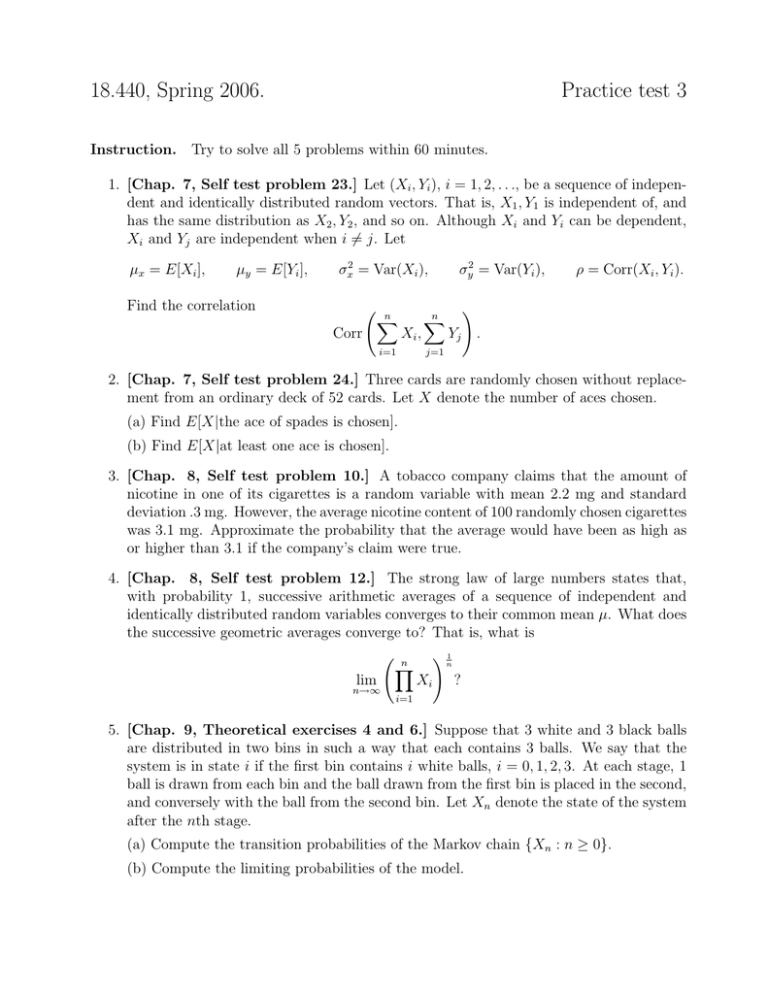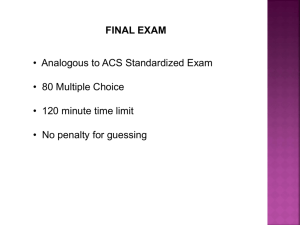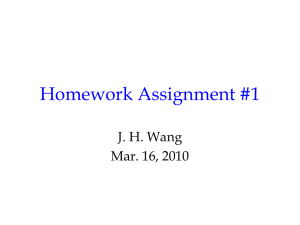18.440, Spring 2006. Practice test 3
advertisement

18.440, Spring 2006.
Practice test 3
Instruction. Try to solve all 5 problems within 60 minutes.
1. [Chap. 7, Self test problem 23.] Let (Xi , Yi ), i = 1, 2, . . ., be a sequence of independent and identically distributed random vectors. That is, X1 , Y1 is independent of, and
has the same distribution as X2 , Y2 , and so on. Although Xi and Yi can be dependent,
Xi and Yj are independent when i 6= j. Let
µx = E[Xi ],
µy = E[Yi ],
σx2 = Var(Xi ),
Find the correlation
Corr
n
X
Xi ,
i=1
n
X
σy2 = Var(Yi ),
ρ = Corr(Xi , Yi ).
!
Yj
.
j=1
2. [Chap. 7, Self test problem 24.] Three cards are randomly chosen without replacement from an ordinary deck of 52 cards. Let X denote the number of aces chosen.
(a) Find E[X|the ace of spades is chosen].
(b) Find E[X|at least one ace is chosen].
3. [Chap. 8, Self test problem 10.] A tobacco company claims that the amount of
nicotine in one of its cigarettes is a random variable with mean 2.2 mg and standard
deviation .3 mg. However, the average nicotine content of 100 randomly chosen cigarettes
was 3.1 mg. Approximate the probability that the average would have been as high as
or higher than 3.1 if the company’s claim were true.
4. [Chap. 8, Self test problem 12.] The strong law of large numbers states that,
with probability 1, successive arithmetic averages of a sequence of independent and
identically distributed random variables converges to their common mean µ. What does
the successive geometric averages converge to? That is, what is
! n1
n
Y
lim
Xi ?
n→∞
i=1
5. [Chap. 9, Theoretical exercises 4 and 6.] Suppose that 3 white and 3 black balls
are distributed in two bins in such a way that each contains 3 balls. We say that the
system is in state i if the first bin contains i white balls, i = 0, 1, 2, 3. At each stage, 1
ball is drawn from each bin and the ball drawn from the first bin is placed in the second,
and conversely with the ball from the second bin. Let Xn denote the state of the system
after the nth stage.
(a) Compute the transition probabilities of the Markov chain {Xn : n ≥ 0}.
(b) Compute the limiting probabilities of the model.







